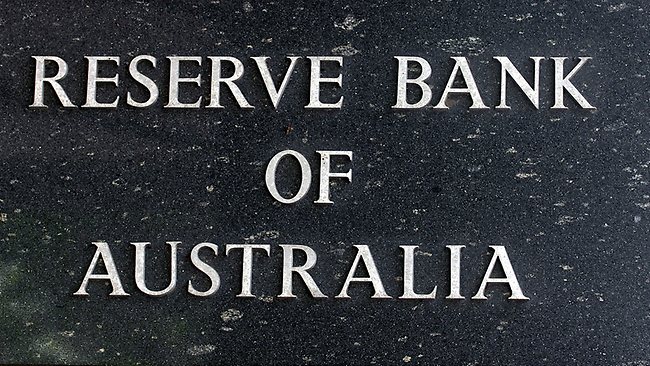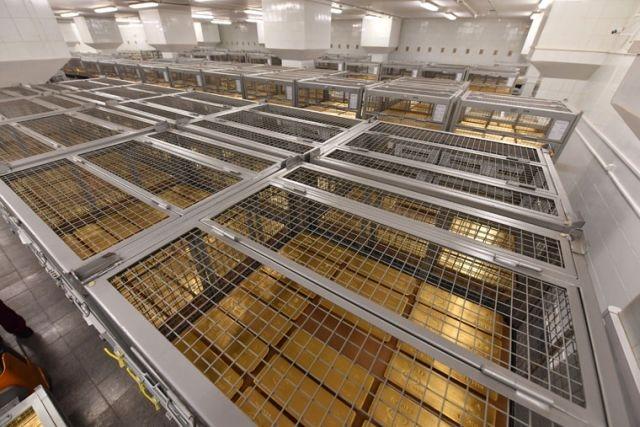Australia’s Gold at the Bank of England
Recently, news network RT.com asked for my comments on the question of the 80 tonnes of the Reserve Bank of Australia’s (RBA) gold reserves and their supposed storage location at the Bank of England’s gold vaults in London. Based on some of those comments, RT has now published an article in its English language news website at www.rt.com about this Australian gold that the RBA claims is held in London.
The RT.com article, which was published on 18 February 2018, is titled “Hey UK! It’s not just Venezuela, what happened to Australia’s gold?“, and can be read in full here on the RT website.
For the commentary, RT actually asked me quite a few interesting questions on both the Australian gold and other related gold topics. Since both the extended questions and the answers might be of interest to readers, we have decided to publish below the full set of questions and answers in Q&A format, which are as follows:
1) What happened to Australia’s gold? What’s your opinion?
The Reserve Bank of Australia (RBA) claims to have 80 tonnes of gold bars stored in a bailment arrangement, in an allocated gold account, at the Bank of England vaults in London. Bailment means the Bank of England is custodian, and the RBA owns and has title to specific serial numbered gold bars.
However, there have never been any independent physical audits of this gold, which means that there is no way to verify the RBA’s claim that it has all the gold that it claims to have.
In 2013, the Bank of England allowed the RBA to do a partial audit of some of the claimed RBA gold holdings, but the results of this audit remain secret, and even after FOIA requests, the documents from this audit were blocked by both the Bank of England and the RBA and never released. This also raises a red flag.
Most importantly, the critical document to any gold holding held under bailment is a proper weight list of the gold bar holdings (including refiner serial numbers), and such a list has also never been published by the RBA. Such a weight list is fundamental to any claimed gold holding (for example, think about the gold-backed Exchange Traded Funds (ETFs) which publish their full gold bar weight lists online on a daily basis).
The RBA has not made any gold purchases or sales over the last 20 years, so apart from gold lending, the RBA gold should be the same bars that it has held over at least the last 20 years. It would therefore be a simple matter to publish in a single zipped file all of the versions of the gold bar weight list that this 80 tonnes of gold has represented over the last 20 years. The Bank of England’s gold bar accounting system has all of this information and it would be simple to extract it.
Throughout the last 20 years, the RBA also admits that a lot of its claimed gold holdings have been lent out in the secretive London Gold Lending Market, but there is no information whatsoever available on any of these lending transactions or the serial numbers of the gold bars involved. In other words, there has never even been one snapshot publication of a proper industry standard weight list for these RBA gold bars (by refiner serial numbers), let alone an updated weight list every time the RBA lent out or closed a gold lending deal.
During the years 1999 – 2004, the RBA says that almost all of it’s gold was on loan, and the RBA is still in the gold lending market to this day, for example, 10 tonnes of its claimed 80 tonnes at the Bank of England were said to be on loan during 2018. The important point here is that the gold bars that the RBA would have title to at the completion of a gold lending deal would not be the same bars that it held prior to this gold being lent to a bullion bank in London.
Independent physical audits, full and proper weight lists, details of gold lending transactions, and above all a transparent attitude, would all allow instant verification of the RBA’s claims about the sovereign Australian gold holdings. That the RBA and Bank of England refuse to do any of these things is highly suspicious. Therefore, there is no black and white way to say that the RBA has the 80 tonnes of gold it claims to have.

2) Why are countries like Australia and Canada willing to part with physical gold assets? Is that a good idea in your opinion? How much gold does Australia really have?
Up until late 1996, the Australian central bank held nearly 247 tonnes of gold, a considerable amount of gold by any measurement. However, it then went on a gold selling spree during the first half of 1997 and sold 167 tonnes, leaving it with the current claimed 80 tonnes.So why did the RBA sell this gold? At the time, the usual justifications were wheeled out by the RBA such as that the proceeds of gold sales could be better invested in financial assets, and that other countries were also selling gold at that time, including Canada, Netherlands and Belgium. But, these reasons have always stinked. Firstly, the RBA gold sales occurred just before a huge bull market run-up the gold price between 2000 and 2011, so the RBA made a huge opportunity loss on the gold sales.
Secondly, selling gold just because another central bank is doing is nonsensical and void of investment rationale. The same goes for Canada which basically sold all of its gold, about 500 tonnes, in the late 1990s and early 2000s. Again, there was no investment rationale for doing so and the Canadians seem to have been coaxed into these sales by external parties. It’s also interesting that in hindsight, no one in the Canadian Department of Finance ever wanted to talk about these gold sales later on when asked by the media or investigative journalists.
Of course, it was not a good idea for Australia to sell most of its gold and for Canada to sell all of its gold. The timing of these sales was also some of the worst ever. Beyond this, these central banks acted irresponsibly and had no accountability to the populations of their nations. Gold is the Wealth of Ages, the sovereign wealth of a nation. It is not some securitized financial asset to be sold and squandered by statist central bankers who answer to no one.
3) Some experts believe that western central banks are “covertly disposing” of their gold or otherwise leasing it to China and India through bullion banks. Do you believe in that? Do you believe there’s some grand, global gold conspiracy involving the world’s central banks?
There is a mountain of evidence that Western central banks despise the power of gold and will go to great lengths at the highest levels to contain the gold price through coordinated interventions and anti-gold policies. From the London Gold Pool of the 1960s, to the US and IMF gold sales in the 1970s, to the 1980s Gold Pool discussions at the Bank for International Settlements (BIS), to the Bank of England intervening into the London Gold Fixes in the 1980s, G10 central bank governors have often been personally involved in committing to gold market manipulation.
This continued through the 1980s and 1990s with the growth of the secretive gold lending market and central bank gold leasing, the various European central bank gold “agreements" which did the opposite of what they claimed to do, the sabotage of transparent IMF gold accounting policies by the main European central banks in 1999, and the gold price fix manipulation by bullion banks in London where regulators looked the other way. All of this evidence and more is available if anyone wants to look, such as on the GATA website and elsewhere.
As regards the Australian and Canadian gold sales, the more logical explanation for both of these was that they were coordinated gold sales by G10 central banks as part of a plan to fire-fight the physical gold market or to bail out gold short bullion banks, or that the sales were part of secretive gold re-distributions to other countries, such as to China. While this may seem far-fetched, you have to realize that central banks never tell the truth, especially when it comes to the gold market, and that the sheer numbers of central bank gold sales around that time in the 1990s and 2000s, including by the UK and Switzerland, point to something collusive about the sales rationales.
All of these sales were also secretive, with nothing revealed about the identities of the buyers. Any lists of such central bank gold sales, for example in an FOIA connected to the UK’s gold sales, have the identities of the buyers redacted. So its totally possible that a central bank, such as China, was on the receiving end of these gold sales. There is evidence that the UK Treasury gold sales in 1999 done for bullion bank bailout purposes, so this could be true with the RBA sales.
At a broader level, there seems to be collusive policy behind the scenes of western central banks offloading physical gold in a coordinated manner through secretive sales and leasing it to achieve various policy objectives. These objectives include inducing extra gold supply to dampening down the gold price, fire fighting physical shortages, at times bailing out bullion banks, and most intriguingly, redistributing some of the West’s central bank gold holdings to central banks such as the People’s Bank of China. Gold Pools (central bank syndicates) don’t have to take the form of advertised arrangements as in the 1960s. A central bank gold pool exists any time two or more central banks clandestinely use some of their gold holdings in a coordinated way.
You can call this a conspiracy if you want. Try to ask central banks simple questions about their gold and you will see that not one central bank will ever divulge important information about its gold, or its gold operations, or its gold related policy discussions with other central banks. The Bundesbank, the Bank of England, the New York Fed, the Bank for International Settlements, the European Central Bank, the IMF, the Swiss National bank, De Nederlandsche bank, the Swedish Riksbank, the Banque de France, Banca d’Italia. The list is endless. All of these central banks keep a lid on revealing anything substantive about their gold holdings and their gold activities, and none produce proper weights lists of their gold bars.
Due to the secrecy of the gold lending market, there is zero confidence that the Western central banks have the amount of gold that they claim to have.
4) What or who is behind the thinking in the West that after 5,000 years gold is now become obsolete as a store of value?
Gold is the ultimate form of money and a 5000 year old store of value. Gold is no one else’s liability and is the antithesis of central bank fiat currency regimes. Gold is the world’s best inflation barometer and a long term inflation hedge. It is for these reasons that central bankers run in fear of gold and want to disparage gold’s image at every turn and to make gold obsolete as a form of savings and investment.
Who is responsible for this? Those who have been running the Anglo and American and Western European central banks and their London and New York commercial bank counterparts for the last 50 years, the same people who congregate at the BIS in Basel and are represented on the Group of Thirty and the Bretton Woods Committee, i.e. the elitist central bankers and their investment bank backers.

5) If Western countries are disposing of physical gold where does it go?
Physical gold has flown from West to East. Some of these flows have been through normal channels where gold has been sold in the market and moved from London to the Swiss precious metals refineries to be transformed from 400 oz gold bars into smaller higher purity 1 kg and 100 oz gold bars, and onward shipped to India, Hong Kong and China.
Gold has also moved directly to the East via mining exports of South Africa, Australia, Canada, the US and elsewhere, and imported directly into China, Hong Kong and India. Western central bank gold disposals will only show up in these gold flows to the extent that the gold has been classified as non-monetary gold. Any cross-border movements of ‘monetary gold’ (which is central bank gold), will not show up in trade statistics, which is what the central banks like, as they want to keep these transactions in the shadows.
India has imported about 15,000 tonnes of gold since 2001. There are more than 25,000 tonnes of private gold held in India. There are at least 17,000 tonnes of gold held in China, not including the gold holdings of the Chinese central bank. Gold has flowed from the West into India and China, sometimes overtly, sometimes covertly.
Some of the gold that the Western central banks still claim that they hold is in fact not there at all. It has been leased out in London, sold and shipped abroad, and now sits in China or India, and all the while the Western central banks still claim that this gold is on their balance sheets as they maintain the fiction that ‘gold receivables’ are in fact the same as physically held gold.
6) Australian economist John Adams said: “In the last 20 years we’ve only seen the gold once.” According to Adams, the RBA audit was so flawed it was basically meaningless. Is there any chance that the BoE could manufacture bars with fake serial numbers?
The Bank of England allowed Australia’s central bank to do its own partial gold audit in 2013, and to inspect a random sample of the RBA gold bars, This audit was basically meaningless, yes, and was flawed from start to finish.
Knowledge of this gold audit kept out of the public domain and the results of the audit were totally censored and buried. Only via FOIA requests did the Australian public even get a glimpse into what was going on. The FOIA emails and correspondence that the RBA did release were heavily redacted without any details of how many gold bars were selected and what the sample size was, and the results of the audit were not published. No one in any industry would accept such conditions for an audit nor of the so-called audit results.
At no time did the Bank of England supply a proper weight list to the RBA with the refiner serial numbers of the claimed gold holding. The RBA had to select some bars a month in advance and advise the Bank of England of the bars its wanted to examine. This in itself is ridiculous. For example, the SPDR Gold Trust (GLD) has full annual audits of all of its gold holdings (of nearly 800 tonnes), i.e. 10 times more than the RBA holds. Since the GLD can get its gold physically audited twice per year, there is no reason why the RBA cannot.
In July 2013, just before the RBA’s flawed and partial audit, the RBA didn’t even have formal ‘gold safe-custody arrangements’ in place with the Bank of England since it had to ask for “gold safe-custody arrangements between the RBA and the BoE to be formally clarified”. That’s according to a glimpse of some RBA – Bank of England correspondence that did make it out in one of the FOIA emails released.

After the audit, the RBA blocked publication of the audit results document stating that it “would, or could reasonably be expected to, cause damage to’ the relationship between the RBA and the BoE” and that it could “render less effective of procedures or methods for the conduct of tests, examinations or audits’ by the Bank”. This is complete nonsense.
The real reasons that the Bank of England does not allow proper gold bar audits and the real reason that it will never provide central bank customers with proper weight lists of refiner serial numbers is that the Bank of England wants total secrecy about gold lending and where the lent gold goes to. Revealing the refiner serial numbers would blow open the entire central bank – bullion bank gold lending scheme, as the lent gold bars could be identified wherever they turn up. The Bank of England does not need to manufacture fake serial numbers. All it needs to do is prevent any serial numbers of gold bars going into the public domain by keeping the entire inventory of central bank gold bar weight lists a secret.
At the end of the day, it’s important to remember that all central bank gold audits are basically meaningless, not just the gold audit of the RBA. Physical gold audits are only credible if they are unconditional, without any restrictions, and if they are undertaken by independent auditors.
7) The Bank of England is globally recognized as one of, if not the primary destination of choice, for central banks to store their gold reserves. Do you think it’s the right place for Australian gold to be?
No, there is absolutely no need for Australian gold to be in London. Its ridiculous. Australian gold should be stored in Australia. Australia has a sophisticated gold industry and perfectly good infrastructure for storing and handling gold, in fact better than most other countries.
The rationale claimed by the RBA that it stores its gold in London so as to be in proximity to the London Gold Trading market is also wearing thin given that the Bank of England has now confiscated the gold of Venezuela’s central bank, the Banco Central do Venezuela (BCV). This is sovereign gold of another nation which was placed into custody storage by a foreign central bank. It is also absolutely extraordinary that the Bank of England has
All central banks that store gold bars at the Bank of England should now sit up and take note that storing gold at the Bank of England is a wealth hazard fraught with political and confiscational risk. And if any central bank gold custody customer of the Bank of England is too embarrassed to actually ask for its gold back straight up due to heightened confiscational risk factors, the current uncertainty over Brexit can act as a good cover story for worried central banks.

Wisely, for example, all of the Bank of Russia’s gold is held in Russia, in Moscow and St Petersburg. The RBA should do likwise, and store its gold in somewhere such as Canberra, Sydney or Perth.
7) ..continued ….Maybe it’s time for Australia to get it’s gold back? Is that possible?
The Australian central bank could request it’s gold back at any time. Australia has vast logistical experience shipping gold around the world. Likewise, the Bank of England has vast logistical experience shipping physical gold around the world.
Assuming the RBA’s gold is actually in custody in London, the RBA could withdraw this gold at any time. The Perth Mint in Western Australia flies gold around the world all the time. Its entirely feasible that the the Bank of England could contract a company such as Brinks to fly the RBA gold back to Australia in less than 2 days. It should take a maximum of 2-3 weeks to arrange insurance and transport and fly the gold out of Heathrow or one of the other London commercial airports, or even from a military air base such as RAF Mildenhall in Suffolk which the Bank of England has used many times in the past.
8) Do you think the Reserve Bank of Australia has to start building its gold reserves again?
Yes, it is irresponsible that Australia not only sold a majority of its gold at fire sale prices in 1997, but that it has since done nothing to rebuild its strategic monetary gold reserves. All the while, the Asian powers of China and Russia have been doing just that. As one of world’s largest gold mining producers, Australia also has the means at its disposal to rebuild its gold by tapping into primary gold production in the way that the Russian Federation has been doing.
9) Gold has been traditionally recognized as a safe haven asset but its price action has raised some questions. Do you think gold is still worth to be accumulated or maybe it’s time to switch to something else, for example, to silver or palladium?
Gold is money. Gold is a monetary metal with 5000 years of history. The global fiat currency experiment which has been in practice since 1971 is just a blip in time compared to gold’s long and important history. It is therefore dangerous to fixate on the US dollar gold price or the ‘international’ gold price.
This US dollar gold price is set in the fractionally-backed London over-the-counter (OTC) and via COMEX gold futures trading. Both of these markets are essentially trading synthetic paper gold, unallocated gold, cash-settled gold, or screen gold. Call it what you will. The price action of this US dollar quoted gold price does not mean that gold is not a safe haven. Far from it. Physical gold is and always will be a safe haven. Gold demand is still very strong despite what the Western financial media would have you believe. Just look at Asian retail and wholseale gold demand and central bank gold demand in countries such as China, India, Russia, Mongolia, and Kazakhstan.
Popular Blog Posts by Ronan Manly
 How Many Silver Bars Are in the LBMA's London Vaults?
How Many Silver Bars Are in the LBMA's London Vaults?
 ECB Gold Stored in 5 Locations, Won't Disclose Gold Bar List
ECB Gold Stored in 5 Locations, Won't Disclose Gold Bar List
 German Government Escalates War On Gold
German Government Escalates War On Gold
 Polish Central Bank Airlifts 8,000 Gold Bars From London
Polish Central Bank Airlifts 8,000 Gold Bars From London
 Quantum Leap as ABN AMRO Questions Gold Price Discovery
Quantum Leap as ABN AMRO Questions Gold Price Discovery
 How Militaries Use Gold Coins as Emergency Money
How Militaries Use Gold Coins as Emergency Money
 JP Morgan's Nowak Charged With Rigging Precious Metals
JP Morgan's Nowak Charged With Rigging Precious Metals
 Hungary Announces 10-Fold Jump in Gold Reserves
Hungary Announces 10-Fold Jump in Gold Reserves
 Planned in Advance by Central Banks: a 2020 System Reset
Planned in Advance by Central Banks: a 2020 System Reset
 Gold at All Time Highs amid Physical Gold Shortages
Gold at All Time Highs amid Physical Gold Shortages




 Ronan Manly
Ronan Manly 0 Comments
0 Comments










